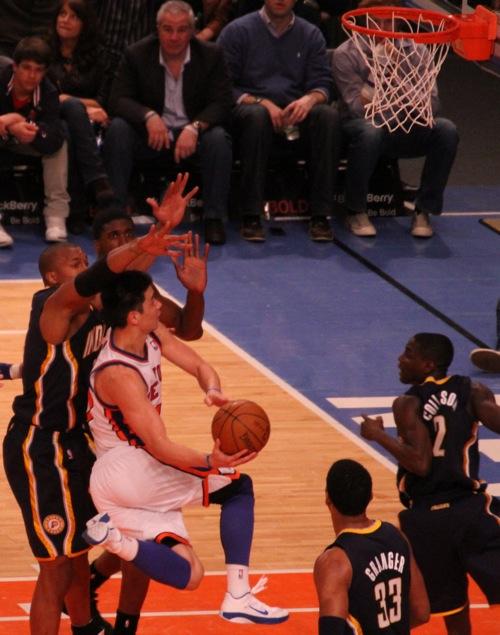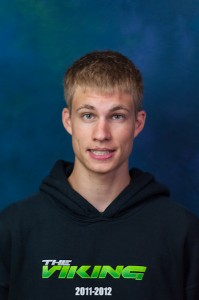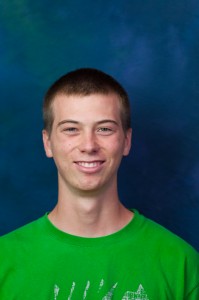AT THE BEGINNING OF FEBRUARY, Jeremy Lin (‘06) was just another NBA benchwarmer, toiling in the depths of the New York Knicks roster and unknown to all but the most loyal of fans.
His claim to fame at the time was limited to his status as the first American player of Chinese or Taiwanese descent to play in the NBA. Still, he had such a low profile that Madison Square Garden security guards regularly confused him for one of the team’s athletic trainers, as Lin humorously pointed out on his Twitter feed in early January.
Knicks coach Mike D’Antoni, desperate for a spark of offense that would ignite his underachieving team, inserted the unheralded Lin into a game against the New Jersey Nets, where he proceeded to drop 25 points and lead the Knicks to a 99-92 victory.
Lin took advantage of his chance to start the next few games, scoring more points in his first five starts than any player in NBA history, including his first career double-double. The highlight of Lin’s rapid ascent came with a career-high 38 points against Kobe Bryant and the Los Angeles Lakers on national television.
A star was undeniably born.
Almost overnight, Lin became the hottest sports story of the year, eclipsing even the ever-present Tim Tebow in the headlines. As his fame continued to grow, media stories began to spring up about Lin, covering nearly every angle imaginable, though most of them had one element in common: The kid came out of nowhere.
Then, just as suddenly as Linsanity swept the nation off its feet, it began to die down.
D’Antoni resigned on March 14, and Lin became yesterday’s news, his strong performances no longer meriting excessive attention.
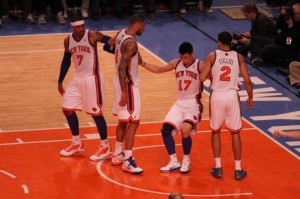
Linsanity then suffered its biggest blow yet when Lin went down with a knee injury in a game against the Detroit Pistons on March 24. As more details emerged, his prospects for the rest of the 2012 season appeared more and more uncertain. It seemed that maybe Lin would be unable to save the Knicks after all.
“You can fall as fast as you rise,” Lin told ESPN’s Rachel Nichols during an interview in February when his popularity first erupted.
Three weeks ago, Lin had surgery to repair a slightly torn meniscus in his left knee, which, much to the dismay of Knicks fans, will likely put an end to his season.
But those who have followed Lin’s career since high school may have a slightly different outlook: they realize that Lin did not come “out of nowhere.” And they may also notice some striking similarities between this season and one seven years ago, when the thought of playing in the NBA was just a pipe dream for Lin.
He was not a Knick back then.
He was a Viking.
IT WAS TUESDAY, and the score was 12-8 when junior point guard Jeremy Lin took over the game. The year was 2005, and Lin’s Palo Alto High School Vikings were trailing an athletic Sequoia High School team from Redwood City in a CCS semifinal game in Santa Clara.
“The game was supposed to be a big test for us,” Lin’s former teammate Kevin Trimble (‘06) wrote in an e-mail. “I remember they had two guards, the Stewart brothers, who were supposed to be really good offensive players, and more athletic than anyone we had.”
Halfway through the first quarter the tide turned, thanks in large part to the efforts of Lin.
“I think [the Sequoia game] was the most amazing thing I’ve ever seen here,” Paly English teacher and basketball aficionado Mike McNulty said.
The next 12 minutes of the game could more aptly be described as “the Jeremy Lin Show.” Lin racked up points, steals, assists and more. When the defense collapsed on his drives, he found Steven Brown (‘06) spotting up at the three-point line. He stole the ball and took it coast-to-coast. At one point, he even threw down the first dunk of his career, an emphatic two-handed slam that teammates vividly remember to this day.
“He had literally never dunked in practice,” ex-teammate Brian Baskauskas (‘05) said. “I don’t think I’d ever seen him dunk, but he gets a fast break in that game and easily dunks with two hands, and we were all [really surprised]. That was pretty crazy.”
The Vikings cruised to a 30-point victory and were set to take on the Archbishop Mitty Monarchs for the CCS Championship.
Coming off this stellar performance, Lin was on the top of the world. He was only a junior and, still growing, had yet to reach his full potential on the court. If not cocky, he could be described as supremely confident in his basketball abilities. So what if he didn’t always practice with the utmost effort he exhibited in games like this?
It is now Thursday, and the Paly basketball team has just finished practicing. It is their last day to prepare for Friday night’s showdown with Mitty, and the workout was intense, as usual. Unlike many of his teammates’, however, Lin’s basketball appetite was not sufficiently satisfied with the multi-hour practice, so he headed over to the local YMCA to get some more shots up before the big game.
By late Thursday evening, Lin has been shooting for a while. He is then invited to join a pick-up game with other players in the gym. Lin accepts, not knowing it will be the last basketball he is going to play for nearly two months.
SNAP! Lin goes down. The short-term result of his decision is painfully clear, but an understanding of the long-term effect requires a trip back to the very beginning, even before Lin first donned the green and white.
LINSANITY ALMOST WASN’T BORN HERE at Palo Alto High School. In fact, if it weren’t for a last-second decision, one of Paly’s greatest and most beloved athletes might have belonged to the archrival; up until his last year at Jane Lathrop Stanford (JLS) Middle School, Jeremy Lin was set to attend Gunn High School and follow in the footsteps of his older brother Josh. However, the possibility of attending cross-town sports powerhouse Palo Alto High became an option when Lin began attending Paly basketball camps run by coach Peter Diepenbrock.
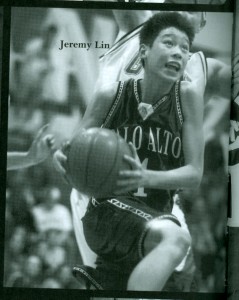
“Jeremy came to my camps when he was in fifth or sixth grade,” Diepenbrock said. “Then one year I was refereeing a game he was playing in at the camp, and I made some calls he didn’t agree with. He did not handle it well, and I got very upset with him. He got really mad at me, and so he left and didn’t come back to camp the next couple years and started doing the Gunn scorebook [keeping stats], and was all set to go to Gunn. [At] the last second, he had a change of heart and decided to come here.”
That change of heart, as Lin later admitted to the Paly Voice in an interview done his senior year, can be attributed not to Paly’s renowned athletic reputation, but to its academics.
“It’s pretty simple why I transferred [to Paly after attending JLS],” Lin said. “The science department here [at Paly] is ridiculously good.”
In addition to taking Advanced Placement (AP) Environmental Science, Lin also took several other AP classes at Paly, including U.S. History, BC Calculus, and Psychology, among others.
Academics have always taken precedent in the Lin household, and Lin’s ability to balance school and basketball contributed to his immediate easygoing and gregarious reputation at school.
“He can get along with almost anybody on campus because he was an athlete and because he also believed in academics,” Paly math teacher Arne Lim, who also advised the Christian Club to which Lin belonged for all four years of high school, said. “He believed he was a student-athlete, not an athlete-student. He got the direction correct. That’s one thing that young folks need to figure out, and the sooner the better.”
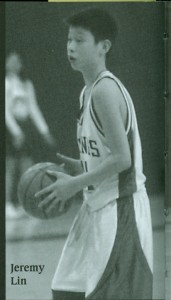
As a high schooler, Lin is also remembered by teammates and teachers alike as being a soft-spoken, humble guy. But all of that changed when he stepped on the basketball court.
Lin’s first season as a Viking came on the JV squad, under the coaching of Trons Grimes. Lin had to repair his relationship with Diepenbrock quickly as he entered the Palo Alto basketball program.
“At some point he admitted that he didn’t have the best attitude and had a hard time dealing with [it] when calls did not go his way,” Diepenbrock said. “Obviously him deciding to go to Paly gave me the idea that all was forgiven.”
Lin had such a strong season with the JV team that he received a late-season call-up to varsity, an uncommon honor for a freshman. The players on the varsity team that year still remember one occasion when Lin entered a game early in the state playoffs, getting some minutes in the fourth quarter of a first-round matchup with Sacramento High School.
“He was tiny back then,” Baskauskas, a sophomore at the time, said. “I do remember him coming in and being this tiny little Asian-American kid who randomly hit a few threes, so we were all surprised.”
McNulty remembers Lin not only hitting a few three pointers, but him connecting from behind the arc on three straight possessions, an uncommon feat for any basketball player, let alone a freshman playing in a postseason varsity game. But as Lin would continue to prove time in and time out, no moment was too big for him.
Lin finished out the season with the varsity team, earning respect from older players and observers alike with his precocious play.
“[Jeremy’s] vision and creativity with deception was unreal when he was a freshman in high school,” Lin’s shooting coach Doc Scheppler, who is also the current Pinewood girls’ varsity basketball coach, wrote in an e-mail interview.
Come sophomore year, Lin became a permanent member of the squad. He competed with Robert Anderson (‘04), a senior, for the job of starting point guard, and the constant competition at practice took a bit of a toll on the young Lin.
“I was the guy that had to [guard him] every day in practice those first two years, and you know, it was a little tough on him,” Anderson said. “It was tough, but it was good for him in the end.”
Lin ended up winning the position by the end of the year, but he still did not always give his full effort at every practice. If drills were not competitive, Lin was simply not motivated to perform at a high level.
“When it was a more non-competitive drill like defensive fundamentals, his performance would be lower because he just wasn’t excited about it, wasn’t motivated to do it and didn’t see how it could help him,” Diepenbrock said.
Nonetheless, even with Lin’s occasionally lackadaisical practice effort, he still had a fairly good season as an underclassman starting for the varsity team.
“Sophomore year was OK as a starting point guard on varsity, but not super,” Diepenbrock said. “[Jeremy] was on a very talented team but he really had not grown much physically, so he was still pretty small and not real strong. He was a nice point guard on a very good team, but he was in no way a dominant player.”
While Lin continued to impress with his mature play, certain aspects of his game could have benefited from a better practice effort. As a sophomore, Lin struggled with turnovers all season, as he too often relied on his natural ability to bail him out.
“He always turned the ball over more than any of our other guards,” Drew Durham (‘04) said. “I think that was because he was younger and a little less experienced than some of our other guards, and his athleticism was beyond his basketball I.Q.”
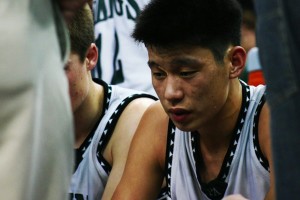
Baskauskas also remembers that Lin could occasionally be headstrong on the court.
“When he was a freshman and sophomore, he was a great player and great kid off the court but sometimes he could be a little difficult to deal with on the court,” Baskauskas said.
The 2003-2004 team won its league but, as Diepenbrock recalls, “ended up losing in the quarterfinals of CCS on a tip-in at the buzzer.”
Lin carried the momentum of his reasonably successful sophomore campaign into his junior year, when, in Diepenbrock’s eyes, he made the biggest improvement of any season in his career. That did not mean, however, that his practice attitude had improved much. His stubbornness, one manifestation of the difficulties to which Baskauskas referred, also remained an issue moving forward.
“I remember him refusing to, for an entire season, shoot a set shot versus a jump shot,” Baskauskas said. “He was way better at shooting a set shot because he wasn’t strong enough to shoot a jump shot yet, but he just insisted on shooting one. And myself, and Coach Diepenbrock and everyone was telling him: ‘Stop shooting that stupid jump shot — you never make it. Shoot a set shot.’ But he just refused and was just being stubborn.”
Moreover, it was not only obstinance that afflicted him that year. In practices, Lin still didn’t always play his hardest because he expected to be able to turn it on come game time.
“When he went into games he basically did what he wanted and was able to be successful, so he didn’t quite get why he needed to work on the things we were working on,” Diepenbrock said.
Lin’s competitiveness remained though, and could be observed even in practice settings when he felt motivated to perform.
“If we did a competitive drill, like if it was five-on-five [where] if you lose you have to run, then his performance would be much better,” Diepenbrock said.
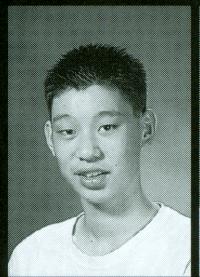
Part of the reason Lin had more of an affinity toward competition than toward practicing the fundamentals of the game may have been because he thought he had already mastered them. Under the tutelage of his longtime Amateur Athletic Union (AAU) travel team coach Jim Sutter, who coached him from fifth grade through the end of high school, Lin had already put in extensive work on fundamentals.
“I’m more of a fundamental basketball coach,” Sutter said. “I’ll go through a two-hour practice now and literally do no sprints, no liners and no scrimmage at all. And all we do is go from one drill to the next. I make an effort to develop the foundations of my players’ success by drilling them with fundamentals. Jeremy would then take the stuff he learned, turn it around, and head over to the Palo Alto YMCA to work on it with his dad and two brothers. [One reason why he didn’t take Diepenbrock’s drills as seriously] was because he was further developed than the other players on that team and that stuff was easy for him.”
Despite Lin’s practice attitude, he continued to excite in games. Throughout his junior year, Lin found success running the offense for an extremely talented Vikings team. Led by Lin and Baskauskas, the two best high school players Diepenbrock ever coached, it was on paper the strongest Paly team Lin was a part of.
“The 2004-2005 team was the most dominant team I’ve ever coached,” Diepenbrock said.
The Vikings cruised to a stellar regular season record, suffering only one loss before the playoffs. The squad easily handled Evergreen Valley in the CCS quarterfinals, pulling off a 20-point victory. Then came Sequoia.
Lin’s paramount performance in the Sequoia game set up a showdown with Mitty for the CCS Championship. But then, on the eve of one of the biggest games of his life, Lin made the fateful decision to head over to the Ross Road YMCA for some additional practice.
Everything was going well, until, according to McNulty, an opposing player in a pickup game Lin joined accidentally stepped on Lin’s foot from behind and injured his ankle. Lin, unsure of the severity of the injury, immediately called both of his trusted coaches, Diepenbrock and Sutter.
“He called me the night of [the injury] and we thought it was a really bad sprain, not a break,” Sutter said.
Diepenbrock immediately tried to determine whether he would be without his starting point guard against Mitty.
“On Friday we spent a lot of time going to a couple doctors and physical therapists and went over to Stanford and talked to their trainer and got confirmation that it was broken,” Diepenbrock said. “So we did play without him in [the Mitty] game.”
Little did Lin know that this would prove to be a defining moment in his career. Forced to watch his teammates play without him, Lin had an epiphany.
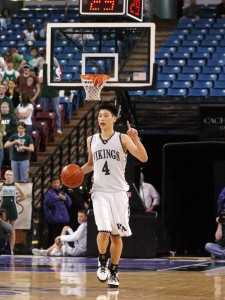
“That made me realize that basketball could be done at any minute, and that one injury could end your career,” Lin said.
Other players also noticed the change in Lin, especially those who had watched him in the preceding years.
“I think that’s when sort of a light when off in his brain, where he was like: ‘This is about more than me. I’m not going to be selfish anymore,’” Baskauskas said. “As he had to watch that playoff run from the bench, that has made him such a better person and player and teammate and leader.”
The playoff run that Baskauskas referereces came in the Northern California playoffs, where the Vikings won multiple games before losing to the eventual State Champions, Oak Ridge.
Lin recovered from his broken ankle to play AAU basketball for Sutter in the summer. Sutter’s Metro Mirage team was primarily made up of Paly varsity players, and according to Sutter was loaded with talent. In one tournament, Lin and Metro took on a team that starred current NBA superstar Kevin Durant and former North Carolina Tar Heel and current Denver Nugget Ty Lawson. Jeremy had the task of guarding Lawson.
“Jeremy without a doubt held his own against Tywon Lawson,” Sutter recalled. “Tywon Lawson didn’t go off on him, and as far as I’m concerned, Jeremy went off on Lawson.”
The Metro Mirage at one point erased a 12-point deficit to garner a two-point lead. However, the unstoppable play of Durant proved too much. Metro lost by five.
Among other opponents, another team Lin’s Mirage took on and beat that same summer was a squad loaded with players from Mater Dei High School in Santa Ana, Calif., in a game that turned out to be prophetic.
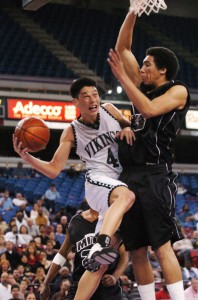
By his senior year, Lin had grown to 6’1” and filled out to about 170 pounds, according to Diepenbrock. Besides growing physically, he had also made strides as a leader. Lin made it clear to all of his teammates that their ultimate goal was a State Championship. However, when the opportunity arose to add a piece to that championship puzzle, Lin made one thing clear: If they were going to win it, they were going to do it with the team they already had.
Diepenbrock recalls that the Vikings had a chance to have a center transfer to Paly, which would fill one of the team’s major holes: height. Although Lin knew and liked the player, his current teammates came first.
“Jeremy just made the comment: ‘Of course it would help us, but that means that one of our guys right here is going to lose a spot and not be able to start,’” Diepenbrock said. “I was definitely taken aback from that and was pretty impressed and surprised that he would have that take on it, considering we had no idea what type of team we were going to have. So, [Jeremy] is a very loyal guy and he has matured a lot.”
In addition to his loyalty and harder work at practice, Lin’s maturity began to manifest itself in other ways. He realized his value as a creator for his teammates. He no longer felt he had to score all the time, and looked to distribute the ball more, to the benefit of the team. Although this year’s squad was not as talented as the group the year before, the 2005-2006 team equaled the one-loss regular season of the previous year.
“Senior year was more of [Jeremy] just being a leader and controlling the game with not nearly as talented a team,” Diepenbrock said.
In the playoffs, the Vikings reeled off win after win, including two victories over Archbishop Mitty, and made it all the way to the State Championship game against heavily favored Mater Dei. Led by the 6’7” Taylor King (‘06), who averaged over 26 points per game, and featuring a 7’1” center named Alex Jacobson (‘07), the Monarchs were ranked sixth in the nation according to MaxPreps.
Unfortunately for Mater Dei, however, the outcome was the same as in the AAU game the previous summer. Lin grabbed eight boards and scored 17 points in the game, burying crucial baskets down the stretch to seal the 51-47 Viking victory.
Having achieved his ultimate high school goal of winning a State Championship, Lin next set his sights on the future. He graduated with a 4.2 GPA and wanted to play basketball in college.
According to a Dec. 2009 article written by ESPN’s Dana O’Neil, despite being widely regarded as “the runaway choice for player of the year by virtually every California publication,” Lin oddly received little interest from UCLA, Stanford University or the University of California at Berkeley, the schools where he most desired to play. Instead of choosing to walk on at either Cal or Stanford, Lin opted to take his talents to Cambridge to play for the Harvard Crimson.
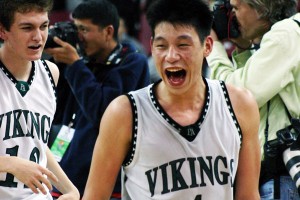
At Harvard, Lin saw significant playing time even as a freshman, averaging over 18 minutes per game in his first year. For the next three years, Lin’s role expanded to the point where he averaged over 30 minutes per game. In each of those three seasons, Lin received All-Ivy League honors and was a finalist for the John Wooden and Bob Cousy Awards his senior year. Among the other highlights of Lin’s senior season was a 30-point performance against the Big East powerhouse Connecticut Huskies.
Despite Lin’s impressive college career, however, professional teams did not show much interest in him. In what was becoming a recurring theme in Lin’s life, teams at the next level continued to doubt his ability and fall for flashier, more athletic players. He went undrafted in the 2010 NBA Draft, although a few teams did pursue signing the enigmatic Lin.
Among them were the Dallas Mavericks and hometown Golden State Warriors, where Lin eventually landed in July 2010. After a disappointing 2010-2011 season in which Lin did not receive much playing time, the Warriors decided to cut him loose at the end of the NBA lockout. The Houston Rockets quickly picked him up, but then released him after just 15 days.
Finally, Lin signed with the New York Knicks in December, where he sat on the bench for several games before he finally got his chance that February 4 less than three months ago. Linsanity then entered the collective vocabulary of the United States.
FOR ALL OF LIN’S FANS who are distraught after the recent news of his injured knee, this voyage to the past ought to offer some consolation. When Lin went down with a broken ankle in 2005, it turned parts of his career around, and helped mold him into the scrappy, gutsy, whatever-it-takes-to-win type of player that he is today.
And while it might seem greedy for Knicks fans to request yet another “miracle” from Lin this season, they can rest assured that he will be back on the court as soon as he’s able, giving everything for his team and taking nothing for granted.
“[After breaking my ankle, I told myself] I’m going to make sure if I [pursue basketball], I’m going to do it working as hard as I possibly can and giving it my 100 percent so that when I look back and when I’m done playing I won’t have any regrets,” Lin told The Viking in New York after the Knicks beat the Indiana Pacers on March 16.
Although this injury puts Linsanity on hold for now, Sports Illustrated writer Pablo Torre, who wrote consecutive cover stories about Lin in mid-February, does not view him as a passing phenomenon as others in the media have.
“I think anybody who doubts Jeremy Lin does so at some peril,” Torre told The Viking in an interview last month. “Everyone said he was dead. The New York Post ran a back page cover of a tombstone that said ‘R.I.P. Linsanity’ last week [March 16]. And now the Knicks have won five in a row [as of March 21] and he’s been arguably their best player again. Anybody who thinks this guy’s a flash in the pan needs to get their eyes checked. It’s ridiculous that people are still doubting him. He could not have had a better start to his [NBA] career.”
The past can often be a telling indicator of what’s to come. And those who remember Lin’s past are certain of one thing: his current injury will not hold him back in the future. If anything, it may even have a positive impact.
It has before.



